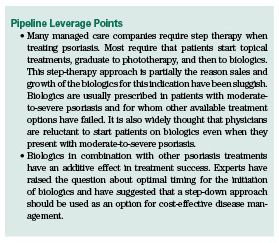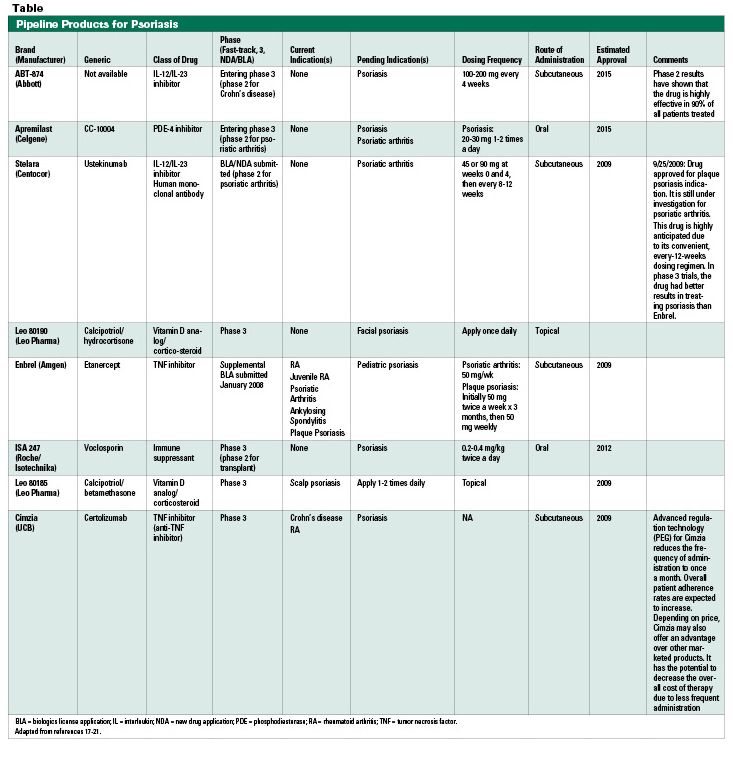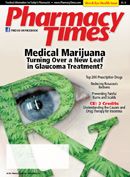Publication
Article
Pharmacy Times
Specialty Pharmaceuticals: Therapy Class Review: Psoriasis
Author(s):
Psoriasis affects approximately 7.5 million Americans, and patients spend up to $3.2 billion annually treating the disease. As biologics become more readily available, pharmacists have an increasing opportunity to create a specialty practice focused on psoriasis.
Psoriasis affects approximately 7.5 million Americans, and patients spend up to $3.2 billion annually treating the disease. As biologics become more readily available, pharmacists have an increasing opportunity to create a specialty practice focused on psoriasis.

Psoriasis is a noncontagious, autoimmune, chronic inflammatory skin condition that affects approximately 7.5 million Americans. Patients with psoriasis may have 1 of 5 types, each with unique signs and symptoms. Plaque psoriasis is the most common type of psoriasis. About 80% of individuals who develop psoriasis have plaque psoriasis, which appears as patches of raised, reddish skin covered by silvery-white scales. These patches, or plaques, frequently form on the elbows, knees, lower back, and scalp. The plaques can occur anywhere on the body, however.1 The National Psoriasis Foundation defines mild psoriasis as affecting <3% of the body; 3% to 10% is considered moderate; >10% is considered severe. The palm of the hand equals 1% of the skin.
The severity of psoriasis is also measured by how it affects an individual’s quality of life. Psoriasis can have a serious impact, even if it involves a small area, such as the palms of the hands or soles of the feet.2 Individuals often experience flares and remissions throughout their life. Controlling the signs and symptoms typically requires lifelong therapy. Common triggers to flare-ups are infections, reaction to certain medications, skin injury, stress, and weather, to name a few.
The 5 types of psoriasis are:
1. Plaque: most common form of the disease; appears as patches of raised, reddish skin covered by silvery-white scales.
2. Guttate: appears as small red spots on the skin.
3. Inverse: occurs in armpits, groin, and skin folds.
4. Pustular: white blisters surrounded by red skin.
5. Erythrodermic: intense redness over large areas.
Between 10% and 30% of patients who develop psoriasis develop a related form of arthritis called psoriatic arthritis, which causes inflammation of the joints. Psoriatic arthritis can cause progressive, disabling joint damage, in addition to the red, itchy skin lesions of psoriasis. The onset of psoriatic arthritis generally occurs in the fourth and fifth decades of life. Men and women are affected equally. The skin disease (psoriasis) and the joint disease (arthritis) often appear separately. In fact, the skin disease precedes the joint disease in nearly 80% of patients.3 Serious health conditions have been associated with psoriasis, including metabolic syndrome, obesity, type 2 diabetes, hypertension, cardiac disease, depression, liver disease, and Crohn’s disease. Patients with severe psoriasis have an increased risk of myocardial infarction independent of other risk factors.4
Economic Impact
• Americans spend between $1.6 billion and $3.2 billion each year to treat the disease, according to the National Psoriasis Foundation (NPF).
• Up to 40% of patients with moderate- to-severe psoriasis are not currently receiving treatment.5
• As many as 39% of patients with moderate-to-severe psoriasis are not receiving treatment in accordance with accepted therapy guidelines.5
• In a 2006 NPF survey, respondents reported the following: 17% have missed work; 10% have missed 1 to 2 days of work in the past month due to their disease. Of those who have missed work in the past month, 74% report missing days of work for psoriasis and/or psoriatic arthritis treatment.6
Biologics are very expensive when compared with traditional topical or systemic therapies. In 2 studies comparing the direct costs of several therapies for moderate-to-severe psoriasis, each reported that methotrexate was the least expensive, ranging from $1200 to $1700, and biologics were the most expensive, ranging from $16,600 to $34,800. Even though current data on the impact of treatment with biologics on total health care costs are limited, many experts theorize that using biologics will have a positive impact on the health care system. Although costs associated with prescriptions for biologics are high, use of biologics may reduce the overall utilization of health care services (eg, lower rate of hospitalizations and inpatient visits), and thus may potentially decrease total health care costs.7 In a small longitudinal cohort study of North Carolina Medicaid patients with psoriasis who were given biologics, the study found a significantly higher adherence rate with the biologics when compared with other psoriasis medications, and the total health care costs and service utilization was lower with those on biologics.7
Demographic/Prevalence Data
• 5.8 million to 7.5 million Americans have psoriasis.
• 2.2% of American adults have been diagnosed with psoriasis, confirming that psoriasis is a common disease.
• 11% of those diagnosed with psoriasis have also been diagnosed with psoriatic arthritis. This is a prevalence of 0.25% of American adults in the general population.
• Psoriasis prevalence in African Americans was 1.3%, compared with 2.5% of Caucasians.
• Psoriasis often appears between the ages of 15 and 25.
• Psoriatic arthritis usually develops between the ages of 30 and 50.
• Plaque psoriasis is the most common form, affecting approximately 80% to 90% of patients.8
Current Market Observations
Biologic therapies have had a major impact on the psoriasis market since the first agent was approved by the FDA in 2003. In the moderate-to-severe psoriasis market, biologic agents alone totaled over $900 million in 2006. The psoriasis market is currently dominated by 2 classes of biologic agents: tumor necrosis factor (TNF)-alpha inhibitors (Enbrel, Humira, and Remicade) and T-cell modulators (Amevive). TNF-alpha inhibitors currently are the gold standard for psoriasis therapy; however, several new agents are set to enter the market in the near future with a novel mechanism of action. Centocor’s Stelara, the first interleukin inhibitor (IL-12/IL-23) in the psoriasis market, Abbott’s ABT-874, and Isotechnika’s voclosporin (ISA247), a small-molecule analogue of cyclosporine with a reportedly much better safety profile, have the potential to radically change the market. The launch of these drugs will not only impact currently available therapies but also expand the share of patients treated with branded agents.
Conclusion
Many of the biologics used to treat psoriasis are widely available to community pharmacies and are not limited by the manufacturer to a network of specialty pharmacies. Given the wide availability of these products and the large number of psoriasis patients, it would appear to be an ideal market in which community pharmacists could build a specialty practice. It should also be a rewarding practice for pharmacists, as bringing support and relief to these patients has a major positive impact on their quality of life. â–



Mr. Allinson is chief executive officer and chief clinical officer of Therigy, LLC.
References
1. Psoriasis NET. SkinCarePhysicians.com Web site. www.skincarephysicians.com/psoriasisnet/index.html. Accessed July 23, 2008.
2. National Psoriasis Foundation Web site. www.psoriasis.org. Accessed July 23, 2009.
3. Psoriatic Arthritis. Medicinenet.com Web site. www.medicinenet.com/psoriatic_arthritis/article.htm. Accessed July 16, 2008.
4. Gelfand JM, Neimann AL, Shin DB, Wang X, Margolis DJ, Troxel AB. Risk of myocardial infarction in patients with psoriasis. JAMA. 2006;296(14):1735-1741.
5. Treatment Pattern Snapshot 2007 poster presentation. National Psoriasis Foundation.
6. Horn L. Psoriasis impacts daily life and carries a substantial burden. National Psoriasis Foundation Survey Panel 2006.
7. Bhosle MJ, Feldman SR, Camacho FT, Whitmire TJ, Nahata MC, Balkrishnan R. Medication adherence and health care costs associated with biologics in medicaid-enrolled patients with psoriasis. J Dermatolog Treat. 2006;17(5):294-301.
8. Menter A, Gottlieb A, Feldman SR, et al. Guidelines of the care for the management of psoriasis and psoriatic arthritis: Section 1. Overview of psoriasis and guidelines of care for the treatment of psoriasis with biologics. J Am Acad Dermatol. 2008;58(5):826-850.
9. Amevive [package insert]. Deerfield, IL: Astellas Pharma US; 2006.
10. Enbrel [package insert]. Thousand Oaks, CA: Immunex Corporation; 2009.
11. Humira [package insert]. North Chicago IL: Abbott Laboratories; 2009.
12. Vectical [package insert]. Fort Worth, TX: Galderma Laboratories; 2009.
13. Remicade [package insert]. Malvern, PA: Centocor Inc; 2009.
14. Taclonex [package insert]. Parsippany, NJ: LEO Pharma Inc; 2009.
15. Simponi [package insert]. Horsham, PA: Centocor Ortho Biotech Inc; 2009.
16. Stelara [package insert]. Horsham, PA: Centocor Ortho Biotech Inc; 2009.
17. Biopharm Insight database. Accessed July 1, 2008.
18. US FDA Web site. www.FDA.gov. Accessed July 1, 2009.
19. CenterWatch Clinical Trials Listing Service. www.Centerwatch.com. Accessed July 1, 2009.
20. US Clinical Trials Web site. www.clinicaltrials.gov. Accessed July 1, 2009.
21. United States Patent and Trademark Office Web site. www.uspto.gov/web/offices/pac/dapp/opla/term/156.html. Accessed July 1, 2009.







